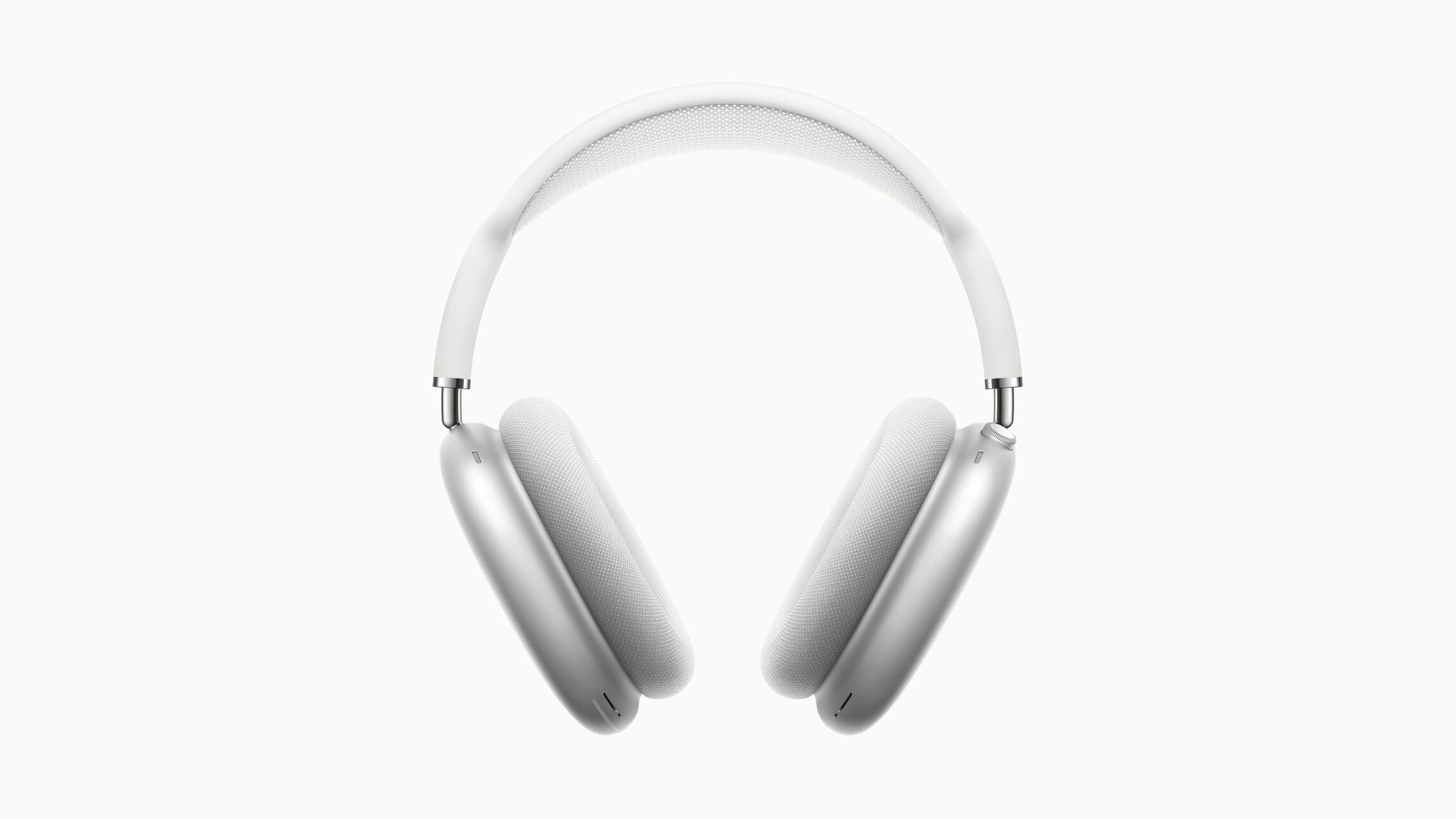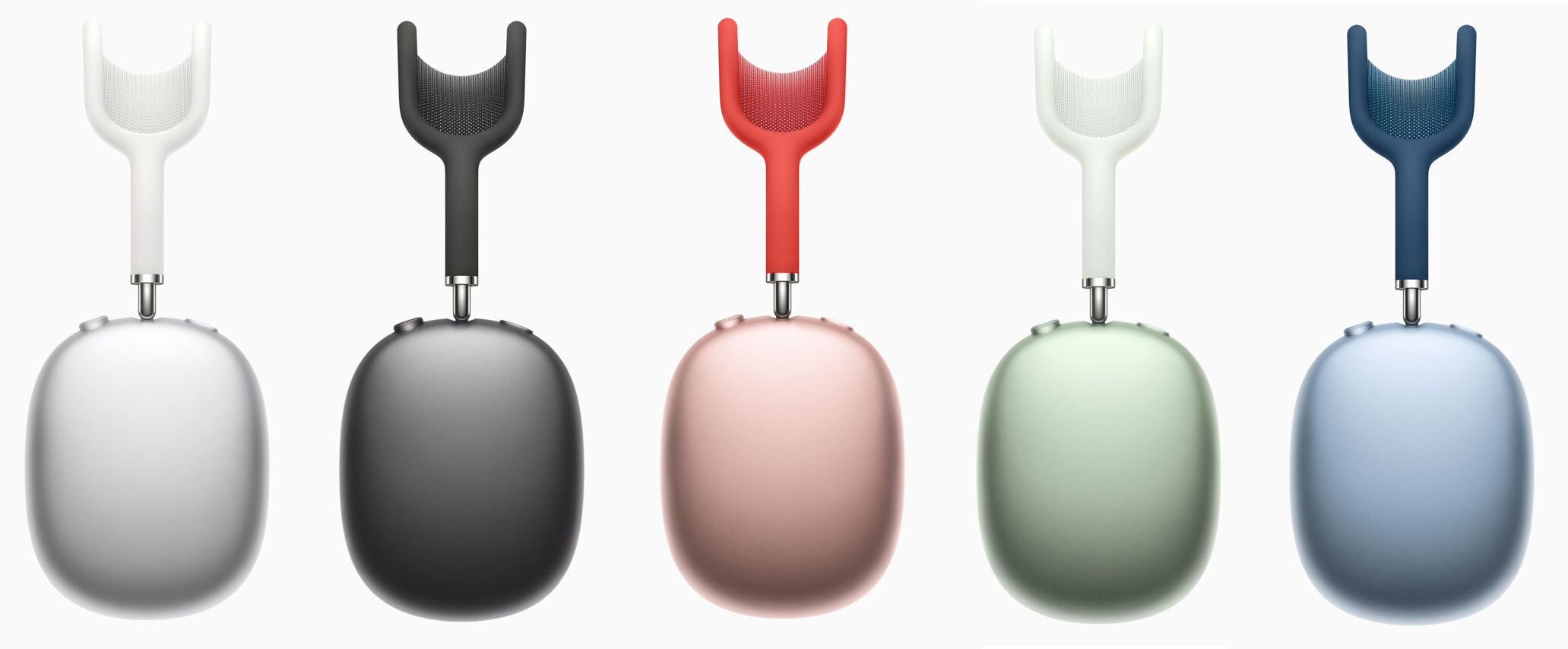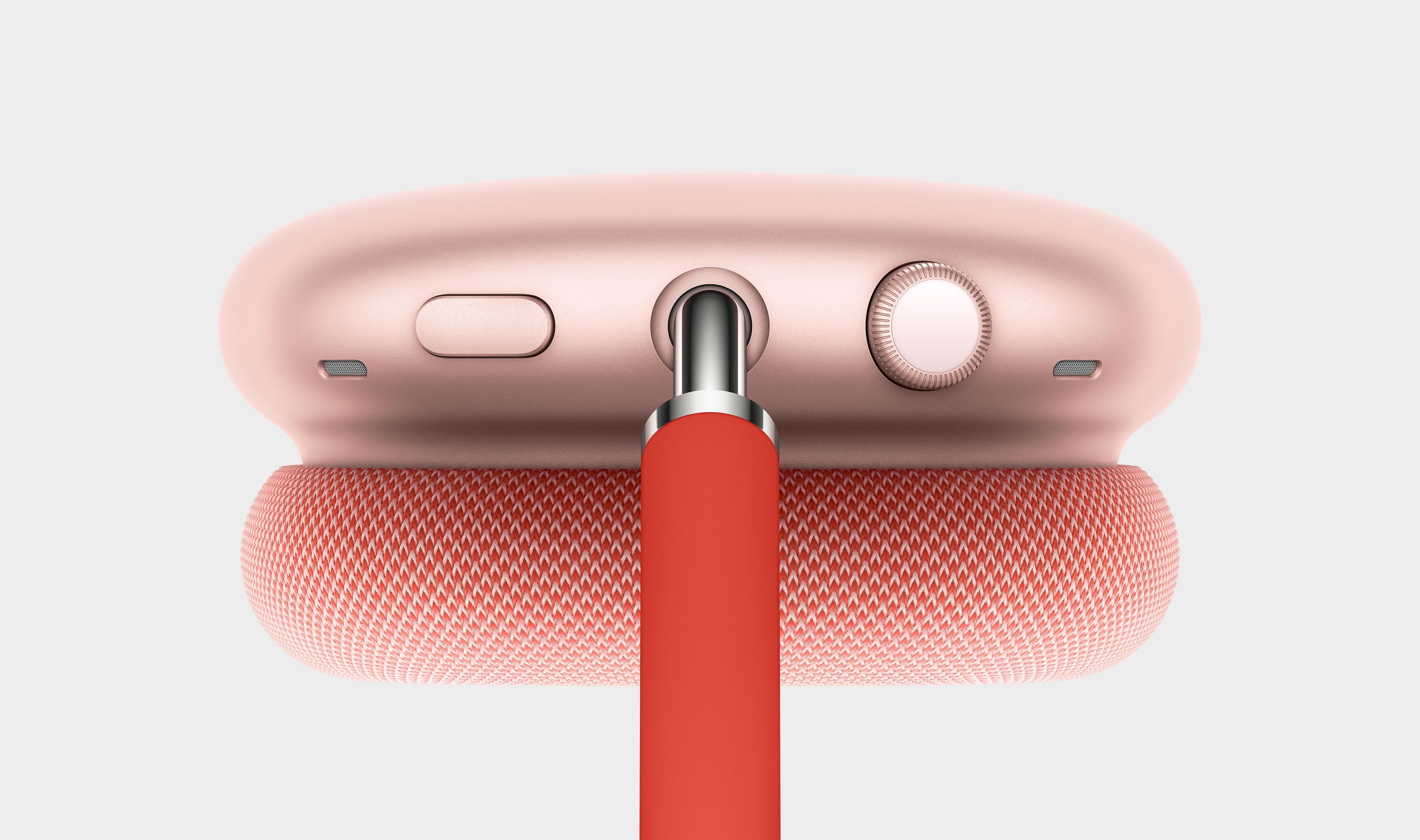Ear detection is not a killer feature unless you have a visual impairment and no tactile sense. That wouldn't even justify this price. Any bluetooth ear/head phones above $250 are a joke and not worth the price. If it's just a class statement, then whatever..I could justify every penny of $549 IF the Airpods Max had just ONE killer feature...just one must have feature that no other headphones have. If they had ear detection so it could detect which ear is which meaning no right or wrong way to put the headphones on - I would spring for it because it actually solves a problem. The AirPods Max at $549 needs one killer feature...
Got a tip for us?
Let us know
Become a MacRumors Supporter for $50/year with no ads, ability to filter front page stories, and private forums.
Apple Announces AirPods Max Over-Ear Headphones With Noise Cancellation, Priced at $549
- Thread starter MacRumors
- Start date
- Sort by reaction score
You are using an out of date browser. It may not display this or other websites correctly.
You should upgrade or use an alternative browser.
You should upgrade or use an alternative browser.
As with the Magic Mouse, this hardly seems like the end of the world:No wired mode using USB-C when the battery dies?
https://www.apple.com/airpods-max/specs said:5 minutes of charge time provides around 1.5 hours of listening time
They have the same killer feature all AirPods have; the ability to switch back and forth between several devices without becoming overwhelmed with murderous rage. And if you think that's not a killer feature, go buy a pair of those amazing XM4's everyone seemingly drools over, try it and see what happens. See how you feel after your first attempt. At best you might last an hour before a strong desire to frisbee them into the horizon sets in.I could justify every penny of $549 IF the Airpods Max had just ONE killer feature...just one must have feature that no other headphones have. If they had ear detection so it could detect which ear is which meaning no right or wrong way to put the headphones on - I would spring for it because it actually solves a problem. The AirPods Max at $549 needs one killer feature...
Also can everyone please stop banging on and on and on about potential sound quality. They're bluetooth headphones with (as far as anyone is currently aware) the same 256Kbps AAC. They will sound "pretty good" at best, which isn't a bad thing. Just understand there is no such thing as bluetooth headphones with amazing sound quality.
As it should be.us the consumers will vote with our ears and our wallets.
To you.Any bluetooth ear/head phones above $250 are a joke and not worth the price
Also can everyone please stop banging on and on and on about potential sound quality. They're bluetooth headphones with (as far as anyone is currently aware) the same 256Kbps AAC. They will sound "pretty good" at best, which isn't a bad thing. Just understand there is no such thing as bluetooth headphones with amazing sound quality.
Apple's implementation of 256 kbps AAC over bluetooth can send distortion and noise floor below audible levels and extends frequency response decently high to cover for most users and most musical content : https://www.soundguys.com/the-ultimate-guide-to-bluetooth-headphones-aac-20296/
Way more important is their frequency response curve at your own eardrum.
I think that's where the two H1 processors and computational audio comes in.They're bluetooth headphones with (as far as anyone is currently aware) the same 256Kbps AAC. They will sound "pretty good" at best, which isn't a bad thing. Just understand there is no such thing as bluetooth headphones with amazing sound quality.
Um, yes it does matter if the speakers are capable of reproducing frequencies outside the normal hearing range. Those frequencies impact those you can hear. It's been proven. It's not as pointless as you imply. Secondly, yes, you do want to see the curve - is the response flat at the speaker. If it's producing a flat line in the frequency range you are listening for, the speaker won't be the influence on the reproduced sound. You can then control, or taylor the sound beyond that. Simple. And yes, they can put it on a spec sheet. All of this they can put on a spec sheet. To argue otherwise is just...ignorant. You know a company who doesn't do this? Bose. They sell cheap crap to consumers at a premium. Won't provide the stats and let anyone publish them with their own tests. Go after them if they do. It's BS - you work at Bose? Could explain your idiotic argument.
Where to even begin with this ?
Perhaps there, where you'll learn that there is no such thing as a "flat at the speaker" (whatever that means to you) FR curve for headphones and that it isn't even desirable to begin with : https://www.headphonesty.com/2020/04/harman-target-curves-part-1/
Apple's implementation of 256 kbps AAC over bluetooth can send distortion and noise floor below audible levels and extends frequency response decently high to cover for most users and most musical content : https://www.soundguys.com/the-ultimate-guide-to-bluetooth-headphones-aac-20296/
Way more important is their frequency response curve at your own eardrum.
They could have an M1X in each ear, it's still 256 AAC over bluetooth at the end of the day. Just trying to help people understand that "pretty good" is the ceiling for all bluetooth headphone audio quality. AirPods Max are no exception.I think that's where the two H1 processors and computational audio comes in.
Are you sure about your hypothesis , I don't agree with it ? how is a 1200$ phone is more attainable then a 550$ headphones ? its 2x the price , how are the MBP`s attainable ?The problem here is it's another in a long line of departures from Apple's historical philosophy: finding sweet spots of the market to make excellent products that are more expensive, but still attainable. This isn't it. That's why people are complaining about this. It doesn't really matter how good the headphones are. It's not consistent with what the brand has been about.
The problem here is the perceived value of Audio devices in the global market , the market decided that headphones are a commodity and the difference in price vs the more high end is not warranted and considered gouging , but in the higher end headphones community they value things differently and they are paying premium prices if the product meets certain goals ,thus we have a market for 500/1000/2000+$ headphones.
550$ is not expensive vs most of Apple products , and in such the only thing you could argue is not about "attainable or not" but if Audio device should/could command high prices or not , but that's beyond the point you tried making.
Not really. 256 AAC is so close to transparent that it has created tens of thousands of posts at places like Head-Fi where people argue over whether there is an audible difference or not, and whether the test was done single blind, double blind, et al. The differences are tiny.They could have an M1X in each ear, it's still 256 AAC over bluetooth at the end of the day. Just trying to help people understand that "pretty good" is the ceiling for all bluetooth headphone audio quality. AirPods Max are no exception.
Whereas the frequency response change that occurs for speakers in a real-world open room, or for headphones on each individuals head varies tremendously, and changes over time. The ability to tune for these changes on the fly is a potential game changer orders of magnitude more important than which mostly transparent codec is used, or whether your cable has a silver or platinum core.
Expensive in the States, even more so in Europe... Even taking into account VAT to be added, Apple slaps on a 15% surcharge on the old continent.
Lots of people shocked by the price... and I agree it's a bit salty. But maybe the sound quality will be worth it? 500-600$ might be appropriate if they sound as good or better than other headphones in the same price range. These could be the Cinema Display XDR of the headphone world.
You aren’t helping people. If distortion, noise floor are below audible levels and frequency response is high enough, it’s transparent.They could have an M1X in each ear, it's still 256 AAC over bluetooth at the end of the day. Just trying to help people understand that "pretty good" is the ceiling for all bluetooth headphone audio quality. AirPods Max are no exception.
with audio over BT it’s a big if but these things can be measured and already have.
In the case of Apple’s products so far what’s been measured in that regard indicates that it’s largely enough for it to not be the most salient priority in the list of stuff you should worry about in terms of SQ.
Not really. 256 AAC is so close to transparent that it has created tens of thousands of posts at places like Head-Fi where people argue over whether there is an audible difference or not, and whether the test was done single blind, double blind, et al. The differences are tiny.
Whereas the frequency response change that occurs for speakers in a real-world open room, or for headphones on each individuals head varies tremendously, and changes over time. The ability to tune for these changes on the fly is a potential game changer orders of magnitude more important than which mostly transparent codec is used, or whether your cable has a silver or platinum core.
Cool. None of this matters regarding expectations of audio quality from AirPods Max though. How am I not helping people by letting them know exactly what they will sound like? Apple has not invented some breakthrough bluetooth audio technology, if they did it would take up the first 50% of the product page.You aren’t helping people. If distortion, noise floor are below audible levels and frequency response is high enough, it’s transparent.
with audio over BT it’s a big if but these things can be measured and already have.
You have no idea what these will sound like, and you make yourself look like a fool by claiming you do. You clearly missed the entire point of my post.Cool. None of this matters regarding expectations of audio quality from AirPods Max though. How am I not helping people by letting them know exactly what they will sound like? Apple has not invented some breakthrough bluetooth audio technology, if they did it would take up the first 50% of the product page.
What bothers me is the pricing not because it’s high but because it’s targeted at an audience that shouldn’t be buying them and are up to their eyeballs in student debt hoping the govt bails them out.
Apple today introduced new wireless over-ear headphones called AirPods Max, with key features including high-fidelity audio, Adaptive EQ, Active Noise Cancellation, and spatial audio. Priced at $549, the headphones can be ordered starting today on Apple.com and in the Apple Store app, with availability beginning December 15.

AirPods Max come in five colors, including space gray, silver, sky blue, green, and pink. Apple says the headphones feature a "breathable knit mesh" spanning the stainless steel headband that distributes weight to reduce on-head pressure.
Subscribe to the MacRumors YouTube channel for more videos.
Apple says the ear cups have acoustically engineered memory foam to create an effective seal, and the telescoping headband arms smoothly extend and then stay in place to maintain the desired fit on your head.

AirPods Max feature a 40-mm Apple-designed dynamic driver that is said to provide "rich, deep bass, accurate mid-ranges, and crisp, clean high-frequency extension." Each ear cup is equipped with Apple's H1 chip for "computational audio" to deliver the "highest quality listening experience possible," according to Apple.
Similar to the Apple Watch, AirPods Max feature a Digital Crown on one ear cup for precise volume control and the ability to play or pause audio, skip tracks, answer or end phone calls, and activate Siri voice control. There's also a noise control button for switching between Active Noise Cancellation and Transparency mode, which lets some outside sound in so you can interact naturally with your surroundings.

AirPods Max feature up to 20 hours of battery life with Active Noise Cancellation and spatial audio enabled — fine print reveals that Apple had volume set to 50% during its testing. Apple says a five-minute charge delivers 1.5 hours of listening time.
As with other AirPods models, AirPods Max have one-tap setup and automatic pairing with all the devices signed in to a user's iCloud account, including the iPhone, iPad, Mac, Apple Watch, and Apple TV. AirPods Max have built-in optical and position sensors that automatically detect when the headphones are on someone's head. Once in place, AirPods Max play audio and can pause once removed, or when the user lifts one ear cup.
Apple's announcement provides more details on audio features:For phone calls and Siri commands, beam-forming microphones help to block out ambient noise and focus on the user's voice.
AirPods Max come with a carrying case called the "Smart Case" and a Lightning to USB-C cable in the box. Apple says the Smart Case puts the AirPods Max in an ultra-low power state that helps to preserve battery charge when not in use.
AirPods Max are launching in the United States and more than 25 other countries and regions, with shipments set to begin arriving to customers on Tuesday, December 15. AirPods Max can be ordered on Apple.com starting today.
More Coverage
- AppleCare+ Coverage for AirPods Max Headphones Costs $59
- Apple's AirPods Max Weigh 384 Grams, Heavier Than Most Competing Over-Ear Headphones
- Apple to Charge $79 for AirPods Max Out-of-Warranty Battery Service
- AirPods Max Missing Rumored Features: $350 'Sport' Model, Swappable Bands, Touch Controls
- AirPods Max Ear Cushions Attach Magnetically, Replacement Cushions 'Coming Soon' for $69
- PSA: AirPods Max Ship Faster With Engraving
- AirPods Max Don't Contain U1 Chip for Ultra Wideband
- Track your AirPods Max Pre-orders on the forums
Article Link: Apple Announces AirPods Max Over-Ear Headphones With Noise Cancellation, Priced at $549
On a side note how many here have actually used high quality cans? They ruin most things you listen to because of their quality. Anything compressed you pick up. Enjoy watching movies or TV shows hearing the audio tracks cut at the end of each sentence.
I never seen so much hate for a product release by folks who never wanted to buy said product , absolutely madness !
I hope its down to 2020 , and not human kind getting so aggressive over things like a product release they have no interest in.
I hope its down to 2020 , and not human kind getting so aggressive over things like a product release they have no interest in.
Yes I do have an idea, I understand how speakers and bluetooth works. I've also tried basically every brand of over-ear BT headphones. APM's will sound "pretty good", and nothing beyond that. If you have any reason to believe otherwise please share this secret information, because even Apple, the Overlords of marketing, haven't given a reason.You have no idea what these will sound like, and you make yourself look like a fool by claiming you do.
The amount of irony here is liquifying my internal organs.You clearly missed the entire point of my post.
Maybe they'll implement it the Apple way. If you put it on the wrong way Siri will tell you "You're using it wrong!"FIVE HUNDRED AND FIFTY DOLLARS?
AND IT DOESNT EVEN HAVE A KEYBOARD -Steve Ballmer (probably)
Press photos show each ear cushion labeled with the correct L and R side. So the rumors suggesting it would determine which ear is left and right was wrong.
Register on MacRumors! This sidebar will go away, and you'll see fewer ads.


